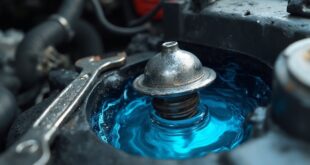A malfunctioning coolant temperature sensor can cause several issues. Drivers may notice inconsistent temperature gauge readings, leading to confusion about engine temperature. Overheating or running too cool is common, along with poor fuel economy characterized by decreased mileage and excessive consumption. Increased emissions may also occur, presenting a risk of failing emission tests. Hard starts, poor idling, and even thick black smoke from the exhaust can indicate sensor problems. Understanding these signs can help prevent further complications.
Inconsistent Temperature Gauge Readings
When the coolant temperature sensor malfunctions, it often results in inconsistent temperature gauge readings, which can confuse drivers.
This inconsistency may manifest as sudden fluctuations or erratic behavior of the gauge, creating uncertainty about the engine's actual temperature. Drivers may find themselves questioning whether the engine is overheating or running too cool, leading to potential misdiagnosis of issues.
Inaccurate readings can also hinder the engine control module's ability to optimize performance, impacting fuel efficiency and emissions.
Consequently, it becomes essential for drivers to address such symptoms promptly to prevent further complications and guarantee reliable vehicle operation.
Engine Overheating or Running Too Cool
Although engine overheating and running too cool may seem like opposing issues, both can stem from a faulty coolant temperature sensor. A malfunctioning sensor can provide incorrect readings to the Engine Control Module, disrupting the cooling system's operation.
This can lead to the engine overheating due to insufficient coolant circulation or failing to activate the cooling fan. Conversely, it may signal that the engine is cooler than it actually is, causing inefficient fuel combustion.
Both scenarios can result in severe engine damage if not addressed promptly, emphasizing the importance of monitoring temperature readings and maintaining the cooling system regularly.
Poor Fuel Economy
A faulty coolant temperature sensor can considerably impact fuel economy, contributing to excessive fuel consumption. This malfunction typically leads to an incorrect air-fuel mixture, causing the engine to operate inefficiently.
Drivers may notice significant drops in mileage, resulting in higher fuel costs over time. Key indicators of poor fuel economy due to a faulty sensor include:
- Decreased miles per gallon (MPG) compared to normal performance.
- Thick black smoke from the exhaust, signaling incomplete combustion.
- A persistent Check Engine Light, indicating potential sensor-related issues.
Addressing these signs promptly can help restore ideal fuel efficiency and overall vehicle performance.
Increased Emissions
Increased emissions often signal underlying issues within a vehicle's engine management system, particularly when a coolant temperature sensor malfunctions.
A faulty sensor can mislead the Engine Control Module (ECM) regarding the engine's actual temperature, leading to improper fuel combustion. This mismatch can result in an enriched fuel mixture, producing higher levels of harmful exhaust gases.
Consequently, vehicles may release excessive pollutants, failing emissions tests and potentially violating environmental regulations.
Drivers may notice a strong odor from the exhaust or observe the Check Engine Light illuminating, indicating the need for immediate inspection and repair to restore ideal engine function and minimize emissions.
Hard Starts and Poor Idling
When the coolant temperature sensor malfunctions, it can lead to hard starts and poor idling, considerably affecting a vehicle's drivability.
This issue arises because an inaccurate temperature reading may disrupt the engine's air-fuel mixture, making it difficult for the engine to function efficiently.
As a result, drivers may experience:
- Extended cranking time before the engine starts.
- Unstable engine RPMs during idle, causing vibrations.
- Increased likelihood of stalling, particularly at low speeds.
Addressing a faulty coolant temperature sensor promptly can restore ideal engine performance and enhance overall driving experience.
Thick Black Smoke From Exhaust
Thick black smoke emanating from the exhaust is a clear indicator of incomplete combustion, often linked to a malfunctioning coolant temperature sensor.
When the sensor fails, it may signal a cold engine condition, leading to an overly rich fuel mixture. This excess fuel does not burn completely, resulting in the characteristic black smoke.
Additionally, the improper air-fuel ratio not only affects emissions but also increases fuel consumption, causing further inefficiencies.
Drivers noticing this symptom should address the issue promptly, as neglecting it can lead to more severe engine problems and costly repairs down the line.
Cooling Fan Malfunction
Cooling fan malfunction can occur as a direct consequence of a faulty coolant temperature sensor. When the sensor fails, it may send incorrect signals to the Engine Control Module, preventing the cooling fan from activating. This can lead to overheating and significant engine damage.
Key indicators of cooling fan malfunction include:
- Engine Overheating: The engine temperature rises dangerously high without fan activation.
- Temperature Gauge Irregularities: Fluctuations in temperature readings on the dashboard.
- Increased Emissions: Higher emissions due to poor engine cooling and combustion inefficiency.
Addressing these symptoms quickly can prevent further damage.
Unusual Engine Behavior
Unusual engine behavior often signals underlying issues related to the coolant temperature sensor. Symptoms such as erratic idling, stalling, or difficulty starting can indicate a malfunctioning sensor. These behaviors directly affect engine performance, leading to inefficient operation and potential damage.
| Symptom | Possible Cause |
|---|---|
| Erratic Idling | Incorrect coolant readings |
| Stalling | Overheating or improper mix |
| Hard Starts | Faulty temperature signal |
| Poor Acceleration | Incorrect air-fuel mixture |
| Engine Misfiring | Overly rich or lean conditions |
Immediate attention to these signs is essential for maintaining vehicle health.
Frequently Asked Questions
How Often Should I Replace the Coolant Temperature Sensor?
The coolant temperature sensor should be replaced every 50,000 to 100,000 miles, or during regular maintenance checks. Timely replacement guarantees peak engine performance and prevents potential overheating issues related to coolant temperature misreading.
Can a Bad CTS Affect My Vehicle's Warranty?
A bad coolant temperature sensor can potentially affect a vehicle's warranty. If the issue leads to engine damage due to negligence or improper maintenance, manufacturers may deny warranty claims related to the affected components.
Are There Any DIY Tests for a Faulty CTS?
DIY tests for a faulty coolant temperature sensor include using an OBD-II scanner to check for error codes, performing a visual inspection for damage, and measuring resistance with a multimeter to assess functionality.
What Are the Costs Associated With CTS Replacement?
Costs associated with coolant temperature sensor replacement typically range from $100 to $300, including parts and labor. Factors influencing price include vehicle make, model, and geographic location, as well as additional repairs needed.
Can I Drive With a Failing Coolant Temperature Sensor?
Driving with a failing coolant temperature sensor is not advisable. It can lead to engine overheating or poor performance, potentially resulting in severe damage. Regular monitoring and timely repairs are essential for vehicle health and safety.
 Car Service Land Coupons for Oil change, Tires, Wheel alignment, Brakes, Maintenance
Car Service Land Coupons for Oil change, Tires, Wheel alignment, Brakes, Maintenance




